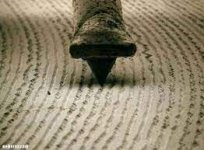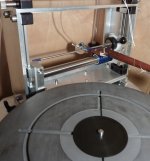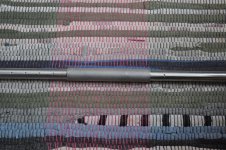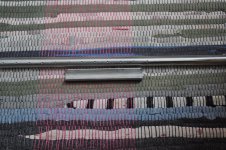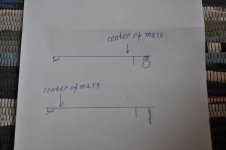There is a possible extra advantage to centring the record that is particularly pertinent to mechanical linear arms.
With the level of eccentricity found on a typical record the arm can spend 40% of the time moving to the right. If the record is centred to within less than the pitch of the groove the arm will only travel to the left. If the arm is moving both left and right bearing friction needs to be the same in both directions. If the arm only moves to the left it doesn't matter what the friction is moving to the right.
The rail can be tilted towards the centre of the record. If the force generated by the weight of the carriage trying to roll down slope is equal to the force required to overcome bearing friction the two will cancel resulting in zero, or at least a much reduced, side forces acting on the stylus.
Of course this would result in VTA changing as the record played. To overcome this the record would need to be tilted by the same amount. This can be achieved in two different ways.
The simplest is that the bearing can be tilted. This has the disadvantage of introducing an additional side load on the bearing. This would probably be less than the side force applied by a belt so not a biggy.
The other way is to make the surface of the platter into a conical dish and press the record into this dish with a screw down clamp. This has the added advantage of reducing warps, acting as a reflex clamp. The disadvantage is the accuracy required in the machining of the platter/mat.
You would need to precisely measure the level of friction of the bearings in order to determine the required slope.
The slope would not need to be very steep, about 1/10 of a degree for my arm, a total drop of less than a fifth of a millimetre across the playing area of the record.
Niffy
With the level of eccentricity found on a typical record the arm can spend 40% of the time moving to the right. If the record is centred to within less than the pitch of the groove the arm will only travel to the left. If the arm is moving both left and right bearing friction needs to be the same in both directions. If the arm only moves to the left it doesn't matter what the friction is moving to the right.
The rail can be tilted towards the centre of the record. If the force generated by the weight of the carriage trying to roll down slope is equal to the force required to overcome bearing friction the two will cancel resulting in zero, or at least a much reduced, side forces acting on the stylus.
Of course this would result in VTA changing as the record played. To overcome this the record would need to be tilted by the same amount. This can be achieved in two different ways.
The simplest is that the bearing can be tilted. This has the disadvantage of introducing an additional side load on the bearing. This would probably be less than the side force applied by a belt so not a biggy.
The other way is to make the surface of the platter into a conical dish and press the record into this dish with a screw down clamp. This has the added advantage of reducing warps, acting as a reflex clamp. The disadvantage is the accuracy required in the machining of the platter/mat.
You would need to precisely measure the level of friction of the bearings in order to determine the required slope.
The slope would not need to be very steep, about 1/10 of a degree for my arm, a total drop of less than a fifth of a millimetre across the playing area of the record.
Niffy
Hi.The main disadvantage of an air bearing is that the air gap is a spring.
Niffy
Let's compare the "spring" of the thin air film with the "spring" of the bearing backlash of the tonearm, what will be the values, or do you think that backlash does not exist
Further, if we consider the modulation of the groove, we see that it has the greatest deviation in the horizontal plane, and this in turn means that the horizontal mass of the tonearm must correspond to it.
The vibrations caused by such a groove will certainly affect the vibration of the bearing of the tone arm, so the tone arm will sing its own song
In my case the tone arm has one rigid structure moving parallel to the airfoil, there are no bushing or ball bearings with their backlash and wobble in them.
In the horizontal area it is a very rigid design, that is where the groove (its modulation) has the most deflection, which means that the hammer (head needle) corresponds to a heavy anvil and will fly off it well.
Attachments
Hi Havun,
I'm not sure what you are asking but I'll have a go.
With a captured type air bearing the air gap is around 5μm, the maximum movement at the bearing at any one point will be considerably less than this, probably less than a micron. It will be much greater with an open style air bearing. The main resonance of the bearing will not be by moving the entire bearing forwards and backwards. It will be a rocking motion, the left moving forward as the right goes back. This rocking will be amplified by the length of the armtube so the movement at the headshell will be greater than the maximum movement at the bearing. Another good reason for using a short armtube.
The cantilever assembly is the only part of the entire record player that you actually want to vibrate so is very different from any unwanted vibrations.
I'm not sure what you mean but the support arm bearings as a linear arm wouldn't have any. If you mean in comparison to a pivoted arm then it will depend on the type of bearing used. Ball race bearings will have play so can be problematic. Most of the best arms seem to use some form of spike to form the bearings. These have zero play and have the additional advantage of coupling the armtube to the supporting structure.
Other vibrations will depend on the design and quality of construction of the deck as a whole.
Reducing any unwanted resonance and vibration will increase sound quality. Even if the resonance of the air gap is small, compared to say the bending modes of the armtube, reducing it or eliminating it will still improve overall sound quality.
Niffy
I'm not sure what you are asking but I'll have a go.
With a captured type air bearing the air gap is around 5μm, the maximum movement at the bearing at any one point will be considerably less than this, probably less than a micron. It will be much greater with an open style air bearing. The main resonance of the bearing will not be by moving the entire bearing forwards and backwards. It will be a rocking motion, the left moving forward as the right goes back. This rocking will be amplified by the length of the armtube so the movement at the headshell will be greater than the maximum movement at the bearing. Another good reason for using a short armtube.
The cantilever assembly is the only part of the entire record player that you actually want to vibrate so is very different from any unwanted vibrations.
I'm not sure what you mean but the support arm bearings as a linear arm wouldn't have any. If you mean in comparison to a pivoted arm then it will depend on the type of bearing used. Ball race bearings will have play so can be problematic. Most of the best arms seem to use some form of spike to form the bearings. These have zero play and have the additional advantage of coupling the armtube to the supporting structure.
Other vibrations will depend on the design and quality of construction of the deck as a whole.
Reducing any unwanted resonance and vibration will increase sound quality. Even if the resonance of the air gap is small, compared to say the bending modes of the armtube, reducing it or eliminating it will still improve overall sound quality.
Niffy
Hi.
In our case practice should always decide, in this case I was interested in the greatest silence during the passage of the needle groove vinyl disk without a music signal, that is on an empty groove.
I used to test all sorts of tonearm designs and materials including expensive woods, there was a hobby about ten years ago, there was so much life energy, now it's even funny .
.
But I've chosen this simple air bearing tonearm out of the whole bunch.
It's my choice, I don't impose it on anyone
In our case practice should always decide, in this case I was interested in the greatest silence during the passage of the needle groove vinyl disk without a music signal, that is on an empty groove.
I used to test all sorts of tonearm designs and materials including expensive woods, there was a hobby about ten years ago, there was so much life energy, now it's even funny
But I've chosen this simple air bearing tonearm out of the whole bunch.
It's my choice, I don't impose it on anyone
Niffy, you've really helped me with my warped record problem. And with many other topics related to linear trackers. A question, though. You mention a 60mm washer underneath the label, which I have approximated by a linear slope rather than a sine. Which part of the sine do you recommend? That is, what is the domain of your curve?
By the way, my current implementation of air tonearm and air turntable, proudly displaying it's Delrin washer.
By the way, my current implementation of air tonearm and air turntable, proudly displaying it's Delrin washer.
Attachments
Hi esls,
My "washer" is recessed into the top of the platter and also serves as the upper part of my bearing. The section of a sine wave it represents is from the centre of a trough, flush with the surface of the platter, at the perimeter rising to the peek, at the spindle. The section surrounding the spindle is therefore horizontal as is the perimeter. The centre is 1.2mm above the perimeter. I made the washer this shape so that it would not overly stress the record. I initially experimented with normal penny washers but these proved less effective at flattening warps and the edge of the washer tended to mark the labels.
The surface of my platter is flat, with no label indent. The clamp pretty much eliminates all warps. It does this to the extent that it works almost as a vacuum hold down. As the clamp is tightened the air under the record is squeezed out. When I remove the clamp the record remains stuck to the platter, held down by atmospheric pressure. I have to pry up the edge of the record to let some air in, then the record pops up and can be easily removed. I keep the nail of my left thumb slightly longer for this very purpose.
If you can't recess your washer it might be an idea to flatten the peek of the cone. Alternatively, if you use a mat, cut a 60mm diameter hole in the mat and make the perimeter of the washer the same thickness as the mat.
Niffy
My "washer" is recessed into the top of the platter and also serves as the upper part of my bearing. The section of a sine wave it represents is from the centre of a trough, flush with the surface of the platter, at the perimeter rising to the peek, at the spindle. The section surrounding the spindle is therefore horizontal as is the perimeter. The centre is 1.2mm above the perimeter. I made the washer this shape so that it would not overly stress the record. I initially experimented with normal penny washers but these proved less effective at flattening warps and the edge of the washer tended to mark the labels.
The surface of my platter is flat, with no label indent. The clamp pretty much eliminates all warps. It does this to the extent that it works almost as a vacuum hold down. As the clamp is tightened the air under the record is squeezed out. When I remove the clamp the record remains stuck to the platter, held down by atmospheric pressure. I have to pry up the edge of the record to let some air in, then the record pops up and can be easily removed. I keep the nail of my left thumb slightly longer for this very purpose.
If you can't recess your washer it might be an idea to flatten the peek of the cone. Alternatively, if you use a mat, cut a 60mm diameter hole in the mat and make the perimeter of the washer the same thickness as the mat.
Niffy
Thank you Niffy! The recess around my spindle is 0.2 mm, so I use that as a base, rising 1.2mm to 1.4mm. Didn't expect a domain of (-pi/2 to +pi/2), but that sure does make sense. So I guess the equation for CNC is (0.2+0.6 + 0.6sin(a)), for a in (-pi/2, +pi/2). Will get onto that.
Thanks so much!!
Thanks so much!!
I have an idea to use an air bearing parallel arm without a weight (weight) and use a spring instead, but this requires another rail with air supply.
Details for this have long been made and lie for several years.
The bottom line is to reduce the horizontal mass of the tonearm and not only.
I've tried this on a regular tonearm (spring instead of weight), it works and avoids one of the biggest resonances that a long shaft on one side and a weight on the other side ringing like a bell.
Details for this have long been made and lie for several years.
The bottom line is to reduce the horizontal mass of the tonearm and not only.
I've tried this on a regular tonearm (spring instead of weight), it works and avoids one of the biggest resonances that a long shaft on one side and a weight on the other side ringing like a bell.
Interesting Havun, I have also minimised such weights by using longer levers and lighter weights. I have experimented with springs as well, but the force varies with extension and makes VTF vary with it, what might one do about that?I have an idea to use an air bearing parallel arm without a weight (weight) and use a spring instead, but this requires another rail with air supply.
Details for this have long been made and lie for several years.
The bottom line is to reduce the horizontal mass of the tonearm and not only.
I've tried this on a regular tonearm (spring instead of weight), it works and avoids one of the biggest resonances that a long shaft on one side and a weight on the other side ringing like a bell.
Best, mike
Hi Havun,
Wouldn't the mass of the second air-bearing/sledge add more horizontal mass than that saved by losing the counterweight?
One of the points I have raised several times in this thread is that higher horizontal effective mass, that is inherent with linear arms, is beneficial.
If you are using a long armtube then the total mass might end up being a bit high due to the need for a heavy counterweight. If using a short armtube the mass of the counterweight will be lower reducing its negative consequences such as the lowering of the arms resonant frequency and increased reflections from the weight.
In my book any additional mass should add to the rigidity of the arm. The addition of the second bearing/sledge will not add to the rigidity of the arm.
Niffy
Wouldn't the mass of the second air-bearing/sledge add more horizontal mass than that saved by losing the counterweight?
One of the points I have raised several times in this thread is that higher horizontal effective mass, that is inherent with linear arms, is beneficial.
If you are using a long armtube then the total mass might end up being a bit high due to the need for a heavy counterweight. If using a short armtube the mass of the counterweight will be lower reducing its negative consequences such as the lowering of the arms resonant frequency and increased reflections from the weight.
In my book any additional mass should add to the rigidity of the arm. The addition of the second bearing/sledge will not add to the rigidity of the arm.
Niffy
Hi esls,Thank you Niffy! The recess around my spindle is 0.2 mm, so I use that as a base, rising 1.2mm to 1.4mm. Didn't expect a domain of (-pi/2 to +pi/2), but that sure does make sense. So I guess the equation for CNC is (0.2+0.6 + 0.6sin(a)), for a in (-pi/2, +pi/2). Will get onto that.
Thanks so much!!
The exact profile of the raised section of the washer is not critical. A shallow cone with a rounded peek would be as good as my design.
I have a record that is pressed from transparent vinyl. To check the contact between the record and the platter I wetted the record with soapy water and clamped it to the platter. Any areas that were not in intimate contact with the platter were easily seen as bubbles. The entire playing surface was in contact with the platter and only lifted away at around the runout groove. The only area that the record touched the washer was the flat central portion. The importance of the curved profile is to reduce stress and to prevent marking the label.
Niffy
Hi Mike56,but the force varies with extension and makes VTF vary with it
Please investigate "constant force springs"
sincerely,
Ralf
Hi.Interesting Havun, I have also minimised such weights by using longer levers and lighter weights. I have experimented with springs as well, but the force varies with extension and makes VTF vary with it, what might one do about that?
Best, mike
It all depends on the length of the spring, a longer length will provide more linearity of its work in this area.
I will be able to put a long spring and dampen it with leather.
Hi Havun,
Wouldn't the mass of the second air-bearing/sledge add more horizontal mass than that saved by losing the counterweight?
One of the points I have raised several times in this thread is that higher horizontal effective mass, that is inherent with linear arms, is beneficial.
If you are using a long armtube then the total mass might end up being a bit high due to the need for a heavy counterweight. If using a short armtube the mass of the counterweight will be lower reducing its negative consequences such as the lowering of the arms resonant frequency and increased reflections from the weight.
In my book any additional mass should add to the rigidity of the arm. The addition of the second bearing/sledge will not add to the rigidity of the arm.
Niffy
We are interested in the stiffness of the structure - the tone arm + the length of the skids, it is this triangle must be large and rigid.
For this purpose, in my design the length of the skid is sufficient (large) to create such stiffness.
Of course, the weight of the additional slide (for the spring mechanism) is several times less (you can weigh it on a scale) than the weight of the load, but this is not the main advantage, the main advantage is the center of mass, it in the case of the spring is moved to the head and it eliminates to a large extent the biggest resonance of all tonearms with the load.
Attachments
Hi Havun,We are interested in the stiffness of the structure - the tone arm + the length of the skids, it is this triangle must be large and rigid.
For this purpose, in my design the length of the skid is sufficient (large) to create such stiffness.
Of course, the weight of the additional slide (for the spring mechanism) is several times less (you can weigh it on a scale) than the weight of the load, but this is not the main advantage, the main advantage is the center of mass, it in the case of the spring is moved to the head and it eliminates to a large extent the biggest resonance of all tonearms with the load.
That all makes sense. As you are not using a moving bearing type design the additional mass of the extra "skid" will be much lower than I had envisaged. It is a very interesting idea.
Have you considered placing the counterbalance spring and skid in front of the main bearing? This would allow you to shorten the armtube as you wouldn't need anything sticking out behind the main bearing. As the lever length from the main bearing to the spring can be made longer a more compliant spring could be used (more linear?). The second air track could be positioned above the armtube so that an extension spring can still be used and to allow easier record changing. The spring could be above or even slightly in front of the cartridge.
Niffy
Niffy,Hi Havun,
Wouldn't the mass of the second air-bearing/sledge add more horizontal mass than that saved by losing the counterweight?
One of the points I have raised several times in this thread is that higher horizontal effective mass, that is inherent with linear arms, is beneficial.
If you are using a long armtube then the total mass might end up being a bit high due to the need for a heavy counterweight. If using a short armtube the mass of the counterweight will be lower reducing its negative consequences such as the lowering of the arms resonant frequency and increased reflections from the weight.
In my book any additional mass should add to the rigidity of the arm. The addition of the second bearing/sledge will not add to the rigidity of the arm.
Niffy
Reducing total mass and increasing the rigidity of the arm are two advantages of a short arm. Besides that, a short arm has very similar horizontal and vertical resonance frequencies. Once the horizontal and vertical resonance frequencies are almost the same, the difference in horizontal and vertical effective masses is not a problem at all. For example, esls' arm has a long arm wand. The horizontal and vertical resonance frequencies are 11 Hz and 7 Hz respectively. My arm has a short arm wand. The horizontal and vertical resonance frequencies are the same for a 3/4" air bearing arm. The same should be true for a mechanical linear arm. However, a short arm wand adds the complexity of arm construction.
Jim
Instead of spring, how about a magnetical counterweight? I thought about it when I was building my tangential pivot arm, but I gave it up because I don't have enough knowledge and experiments.We are interested in the stiffness of the structure - the tone arm + the length of the skids, it is this triangle must be large and rigid.
For this purpose, in my design the length of the skid is sufficient (large) to create such stiffness.
Of course, the weight of the additional slide (for the spring mechanism) is several times less (you can weigh it on a scale) than the weight of the load, but this is not the main advantage, the main advantage is the center of mass, it in the case of the spring is moved to the head and it eliminates to a large extent the biggest resonance of all tonearms with the load.
Hi.Hi Havun,
That all makes sense. As you are not using a moving bearing type design the additional mass of the extra "skid" will be much lower than I had envisaged. It is a very interesting idea.
Have you considered placing the counterbalance spring and skid in front of the main bearing? This would allow you to shorten the armtube as you wouldn't need anything sticking out behind the main bearing. As the lever length from the main bearing to the spring can be made longer a more compliant spring could be used (more linear?). The second air track could be positioned above the armtube so that an extension spring can still be used and to allow easier record changing. The spring could be above or even slightly in front of the cartridge.
Niffy
I am not a supporter of the short tube tonearm, consider it my little whim
First of all it is uncomfortable, it complicates the construction with all kinds of knots, which tend to loosen and create backlash, which we are trying to get away from here.
That is, everything should be extremely simple.
I use a thick-walled tube of small diameter, which already takes the resonance down in frequency.
The second air rail for the spring I plan to place at the bottom of the main one, make a notch on the tube of the tone arm where the load is now and with the help of a thread to adjust the tension by 1.5-2 grams in the area of the needle, it's elementary.
Two air bearings will move in parallel, because the friction in them is minimal, almost absent at all.
It is only necessary to roll up the sleeves and...do.
Hi.Instead of spring, how about a magnetical counterweight? I thought about it when I was building my tangential pivot arm, but I gave it up because I don't have enough knowledge and experiments.
To be honest, I can't imagine how to attach a magnet there and most importantly how to adjust the tracking force of the tonearm with it.
Can you draw a diagram?
I just now realized what you mean, yes-that's an interesting idea.Hi Havun,
Have you considered placing the counterbalance spring and skid in front of the main bearing? This would allow you to shorten the armtube as you wouldn't need anything sticking out behind the main bearing. As the lever length from the main bearing to the spring can be made longer a more compliant spring could be used (more linear?). The second air track could be positioned above the armtube so that an extension spring can still be used and to allow easier record changing. The spring could be above or even slightly in front of the cartridge.
Niffy
But unfortunately in my case is not realizable, because I use only a half-cylinder as a movable carriage.
- Home
- Source & Line
- Analogue Source
- DIY linear tonearm
